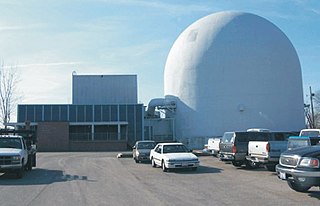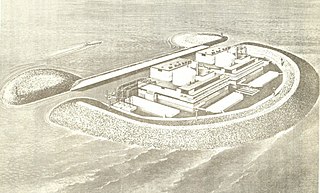Related Research Articles

Galena is a city in the Yukon-Koyukuk Census Area in the U.S. state of Alaska. At the 2020 census the population was 472, slightly up from 470 in 2010. Galena was established in 1918, and a military airfield was built adjacent to the city during World War II. The city was incorporated in 1971.
Westinghouse Electric Company LLC is an American nuclear power company formed in 1999 from the nuclear power division of the original Westinghouse Electric Corporation. It offers nuclear products and services to utilities internationally, including nuclear fuel, service and maintenance, instrumentation, control and design of nuclear power plants. Westinghouse's world headquarters are located in the Pittsburgh suburb of Cranberry Township, Pennsylvania. Brookfield Renewable Partners, a Canadian private equity fund and a subsidiary of Brookfield Asset Management is the majority owner of Westinghouse.

The Limerick Generating Station is a nuclear power plant in Pennsylvania located next to the Schuylkill River in Limerick Township, Montgomery County, northwest of Philadelphia. The facility has two General Electric boiling water reactor (BWR) units, cooled by natural draft cooling towers. According to its owner, Constellation Energy, the two units are capable of producing 2,317 megawatts of power, which combined would provide electricity to around 2 million households. Constellation owns and operates this facility following their separation from Exelon Corporation in 2022. With the exception of refueling outages, Limerick Generating Station continuously operates at 100% power. The plant is connected to the grid, and transmits power, via multiple 500kv transmission lines.

Arkansas Nuclear One (ANO) is a two-unit pressurized water nuclear power plant located on Lake Dardanelle outside Russellville, Arkansas. Owned by Entergy Arkansas and operated by Entergy Nuclear, it is the only nuclear power facility in Arkansas.

The Perry Nuclear Power Plant is located on a 1,100 acres (450 ha) site on Lake Erie, 40 miles (64 km) northeast of Cleveland in North Perry, Ohio, US. The nuclear power plant is owned and operated by Energy Harbor.

The Callaway Plant is a nuclear power plant located on 2,767 acres (1,120 ha) in Callaway County, Missouri, near Fulton, Missouri. It began operating on December 19, 1984. The plant, which is the state's only commercial nuclear unit, has one 1,190-megawatt Westinghouse four-loop pressurized water reactor and a General Electric turbine-generator. It is owned by the Ameren Corporation and operated by subsidiary Ameren Missouri. It is one of several Westinghouse reactors built to a design called Standard Nuclear Unit Power Plant System, or SNUPPS.

The Sequoyah Nuclear Plant is a nuclear power plant located on 525 acres (212 ha) located 7 miles (11 km) east of Soddy-Daisy, Tennessee, and 20 miles (32 km) north of Chattanooga, abutting Chickamauga Lake, on the Tennessee River. The facility is owned and operated by the Tennessee Valley Authority (TVA).

The Virgil C. Summer Nuclear Power Station occupies a site near Jenkinsville, South Carolina, in Fairfield County, South Carolina, approximately 20 miles (32 km) northwest of Columbia.

Columbia Generating Station is a nuclear commercial energy facility located on the Hanford Site, 10 miles (16 km) north of Richland, Washington. It is owned and operated by Energy Northwest, a Washington state, not-for-profit joint operating agency. Licensed by the Nuclear Regulatory Commission in 1983, Columbia first produced electricity in May 1984, and entered commercial operation in December 1984.

The South Texas Project Electric Generating Station, is a nuclear power station southwest of Bay City, Texas, United States. STP occupies a 12,200-acre (4,900 ha) site west of the Colorado River about 90 miles (140 km) southwest of Houston. It consists of two Westinghouse Pressurized Water Reactors and is cooled by a 7,000-acre (2,800 ha) reservoir, which eliminates the need for cooling towers.
The "Nuclear Power 2010 Program" was launched in 2002 by President George W. Bush in 2002, 13 months after the beginning of his presidency, in order to restart orders for nuclear power reactors in the U.S. by providing subsidies for a handful of Generation III+ demonstration plants. The expectation was that these plants would come online by 2010, but it was not met.

The advanced boiling water reactor (ABWR) is a Generation III boiling water reactor. The ABWR is currently offered by GE Hitachi Nuclear Energy (GEH) and Toshiba. The ABWR generates electrical power by using steam to power a turbine connected to a generator; the steam is boiled from water using heat generated by fission reactions within nuclear fuel. Kashiwazaki-Kariwa unit 6 is considered the first Generation III reactor in the world.
The Toshiba 4S is a micro sodium reactor design.

The AP1000 is a nuclear power plant designed and sold by Westinghouse Electric Company. The plant is a pressurized water reactor with improved use of passive nuclear safety and many design features intended to lower its capital cost and improve its economics.

In the United States, nuclear power is provided by 92 commercial reactors with a net capacity of 94.7 gigawatts (GW), with 61 pressurized water reactors and 31 boiling water reactors. In 2019, they produced a total of 809.41 terawatt-hours of electricity, which accounted for 20% of the nation's total electric energy generation. In 2018, nuclear comprised nearly 50 percent of US emission-free energy generation.

The Piqua Nuclear Power Facility was an organic cooled and moderated nuclear reactor which operated just outside the southern city limits of Piqua, Ohio in the United States. The plant contained a 45.5-megawatt (thermal) organically cooled and moderated nuclear reactor. The Piqua facility was built and operated between 1963 and 1966 as a demonstration project by the Atomic Energy Commission. The facility ceased operation in 1966. It was dismantled between 1967 and 1969, and the radioactive coolant and most other radioactive materials were removed. The remaining radioactive structural components of the reactor were entombed in the reactor vessel under sand and concrete.
The Levy County Nuclear Power Plant was a proposed nuclear power plant in Levy County, Florida. Progress Energy Florida originally estimated that the reactors would cost $5 billion and would commence operation in 2016. It later became clear that the Levy County reactors would not have started operation until at least 2026. Since Progress filed its application for the new plant in 2008 demand for electricity had been growing very slowly, and natural gas prices were extremely low at the time. The utility estimated that the reactors would cost between $17 billion and $22 billion, not counting financing charges and cost overruns. According to economist Mark Cooper, opposition to the project has mounted, threatening a rerun of the 1970s and 1980s, when the majority of nuclear construction plans were canceled or abandoned.
The Midland Cogeneration Venture (MCV) is a natural gas-fired electrical and steam co-generation plant in Midland, Michigan owned by Midland Cogeneration Venture Limited Partnership. When it began operation in 1991, it was the largest gas-fired steam recovery power plant in the world.

Between 2007 and 2009, 13 companies applied to the Nuclear Regulatory Commission (NRC) for construction and operating licenses to build 31 new nuclear power reactors in the United States. However, the case for widespread nuclear plant construction has been hampered due to inexpensive natural gas, slow electricity demand growth in a weak US economy, lack of financing, and safety concerns following the Fukushima nuclear accident at a plant built in the early 1970s which occurred in 2011.

Offshore Power Systems (OPS) was a 1970 joint venture between Westinghouse Electric Company, which constructed nuclear generating plants, and Newport News Shipbuilding and Drydock, which had recently merged with Tenneco, to create floating nuclear power plants at Jacksonville, Florida.
References
- Bradner, Tim (2004-12-26). "Galena opens the door to nuclear project". Alaska Journal of Commerce. Archived from the original on 2006-03-22. Retrieved 2006-06-19.
- "Nuclear Power for Galena". Atomic Insights. March 20, 2005.
- Technical documents
- Information from KIYU radio
64°44′26″N156°53′8″W / 64.74056°N 156.88556°W